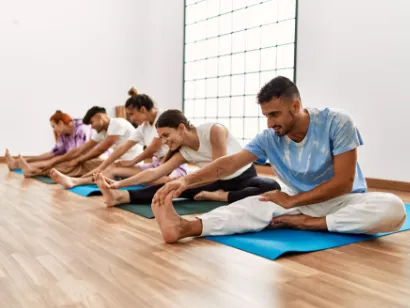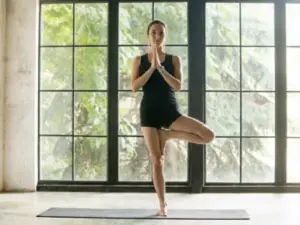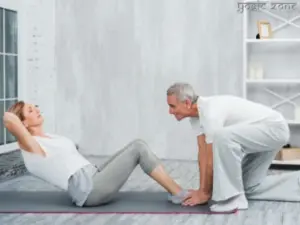
Power Yoga certification | Functional Training | Kidz Yoga | Personal Trainer since 2017 | Martial Arts | Group Yoga Sessions. Know more about Chitra Yelvankar.
Yoga is more than moves and poses: it’s a path to healing, strength, and emotional balance. But with so many different types of yoga available today, how do you choose the one that fits your lifestyle, age, and wellness goals?
In this guide, we explore 10 popular types of yoga commonly practiced. Whether you are a beginner, senior, or someone seeking inner calm, we will help you select the yoga style that meets your needs.

Types of Yoga – At a Glance
| Type of Yoga | Best For | Key Benefits |
|---|---|---|
| Hatha Yoga | Beginners, seniors, and those seeking a gentle start. | Improves flexibility, posture, and mental clarity, reduces stress. |
| Vinyasa Yoga | Active individuals and people who enjoy dynamic, creative movement. | Boosts stamina, coordination, and cardiovascular health. |
| Ashtanga Yoga | Experienced yogis and dedicated athletes seeking discipline. | Builds significant strength, discipline, and endurance. |
| Iyengar Yoga | Seniors, people recovering from injury, and those with chronic pain. | Enhances precision and balance; aids in injury recovery. |
| Kundalini Yoga | Individuals seeking emotional healing and spiritual growth. | Reduces stress, increases self-awareness, strengthens the nervous system. |
| Yin Yoga | Beginners, athletes (for recovery), and those seeking deep relaxation. | Improves joint mobility and flexibility; facilitates deep emotional release. |
| Restorative Yoga | Seniors, people with high stress, anxiety, or chronic fatigue. | Enhances sleep quality, significantly reduces anxiety, calms the nervous system. |
| Chair Yoga | The elderly, people with limited mobility, and those with balance issues. | Increases circulation, gently reduces stiffness, builds confidence. |
| Power Yoga | Individuals with weight loss goals and those focused on strength training. | Boosts energy and stamina, accelerates metabolism, and builds lean muscle. |
| Bikram Yoga | Experienced practitioners comfortable with heat seeking deep detox. | Aids detoxification, deeply improves flexibility, builds mental focus. |
1. Hatha Yoga
Hatha yoga is often considered the parent of all physical yoga styles. It’s a gentle, foundational practice that introduces the basic standing and seated postures, along with simple breathing techniques. Sessions are generally slower-paced, allowing beginners time to understand proper alignment. Read more about restorative yoga for beginners.
- Best for: Absolute beginners, seniors, and anyone seeking a low-impact, stress-reducing introduction to yoga.
- Benefits: Improves flexibility and joint health, corrects posture, aids in stress relief, and builds mental clarity.
2. Vinyasa Yoga
Vinyasa is a smooth, continuous motion where movement is meticulously synchronised with the breath. You move continuously from one position to the next as in a dance.
- Best for: Active individuals, those who enjoy cardio or movement, and people who get bored easily.
- Benefits: Boosts stamina, coordination, and cardiovascular health. The continuous movement helps to detoxify the body. Read more about Vinyasa yoga for seniors.
3. Restorative Yoga
Restorative yoga is the ultimate answer to modern stress. It uses a lot of support props like bolsters, blankets, and eye pillows to support the body. To know how props help, read our article on yoga props for beginners.
- Best for: Seniors, those with high stress or burnout, and anyone dealing with chronic fatigue or anxiety.
- Benefits: Enhances quality of sleep, reduces anxiety, and actively calms the nervous system. Read more about Restorative yoga for beginners.
4. Chair Yoga
Chair yoga is an adaptation where most, if not all, of the poses are performed while seated or using a sturdy chair for support. It makes the benefits of yoga accessible to those with limited mobility, balance issues, or those who use a wheelchair.
- Best for: The elderly, individuals with physical limitations, and beginners who are nervous about standing poses.
- Benefits: Increases circulation, gently reduces stiffness, improves posture even while seated, and builds body awareness and confidence. Read more about Chair yoga for seniors.
5. Iyengar Yoga
Named after its founder, B.K.S. Iyengar, this style focuses on body alignment and precision. Poses are typically held much longer than in Hatha or Vinyasa, and the practice makes extensive use of props like blocks, straps, blankets, and chairs.
- Best for: Seniors, people recovering from injury, and anyone with chronic pain who needs a customised approach.
- Benefits: Improves precision, balance, and stability; helps injury recovery; and develops a deep understanding of one’s own body movements.
Do you have any doubts or questions about this article?? I am Chitra Yelvankar, the author, and I would love to hear from you. Send us your question now!
6. Kundalini Yoga
Often called the “yoga of awareness,” Kundalini is a unique practice that combines rapid, repetitive movements (kriyas), powerful breathwork, chanting (mantra), and meditation. The goal is to awaken the Kundalini energy believed to lie dormant at the base of the spine.
- Best for: Individuals seeking emotional healing, mental clarity, and spiritual growth.
- Benefits: Reduces stress, increases self-awareness, and strengthens the nervous system.
7. Yin Yoga
Yin Yoga is a slow-paced, meditative practice where poses are held for three to five minutes, or even longer. This practice is unique because it targets the deep connective tissues, like ligaments and joints, rather than the muscles. It’s challenging due to the steadiness required.
- Best for: Beginners, highly active athletes, and those seeking deep relaxation and emotional release.
- Benefits: Improves joint mobility and flexibility, lubricates connective tissue, and facilitates a profound emotional release and sense of calm.
8. Ashtanga Yoga
Ashtanga is one of the most physically demanding and highly structured forms of yoga. It follows a fixed sequence of poses that must be mastered before moving to the next.
- Best for: Experienced yogis and dedicated athletes seeking a strong, disciplined practice. Not recommended for beginners due to its intensity.
- Benefits: Builds functional strength, discipline, and endurance. It’s a powerful path for purifying the body and developing focus.
9. Power Yoga
Power yoga is a Western-inspired, fitness-focused style that is influenced by the intensity and smoothness of Ashtanga yoga but without the fixed sequence.
- Best for: Those with weight loss goals, individuals who love a good workout, and people focused on strength training.
- Benefits: Boosts energy and stamina, significantly accelerates metabolism, and builds lean muscle mass.
10. Bikram Yoga
Bikram yoga consists of a precise sequence of postures and two breathing exercises, performed in a room heated to 40.6° C with 40% humidity. The heat is intended to warm the muscles, making them flexible, and cause heavy sweating.
- Best for: Experienced practitioners who are comfortable with heat and seeking a deep, detoxifying practice.
- Note: Consult a doctor if you have blood pressure or heart issues.
- Benefits: Aids detoxification through sweating, deeply improves flexibility, and builds formidable mental focus and stamina.
Choosing the Right Type of Yoga for You
With so many types of yoga to explore, it’s important to identify your current needs and long-term goals. Don’t worry about picking the “perfect” style on the first try; the beauty of yoga lies in its diversity and the freedom to explore.
| Yoga Goal | Recommended Styles | Focus/Benefit |
|---|---|---|
| Gentle Movement & Recovery | Hatha, Chair, Restorative, Yin Yoga | Safe, gentle introduction; ideal for low-impact joint health. |
| Stress Relief & Emotional Wellness | Kundalini, Restorative Yoga | Emotional breakthroughs; deep nervous system calming and anxiety reduction. |
| Fitness & Strength | Vinyasa, Power, Ashtanga Yoga | Vigorous, challenging workouts for building stamina and muscle. |
| Spiritual Growth & Awareness | Kundalini, Hatha Yoga | Structured paths integrating breath, posture, and meditation for greater self-awareness. |
The beauty of yoga lies in its broad offering; these 10 types of yoga offer something for everybody. Explore these types of yoga, try what feels right, and begin your journey with confidence and care.
Do you have any doubts or questions about this article?? I am Chitra Yelvankar, the author, and I would love to hear from you. Send us your question now!
Frequently Asked Questions About Types of Yoga
Which type of yoga is best for beginners?
Beginners typically benefit from styles that focus on alignment and slower movement, such as Hatha yoga or Iyengar yoga. These formats provide structured instruction and are easier to follow compared to faster-paced classes.
What is the difference between Hatha yoga and Vinyasa yoga?
Hatha yoga emphasises holding individual postures with focused breathing, while Vinyasa yoga uses continuous, flowing movements linked to breath. Vinyasa is generally more physically demanding.
Is yoga good for weight loss, and which style is best for burning calories?
Dynamic styles that increase heart rate, such as Vinyasa and Power yoga, may contribute to weight management when practiced consistently alongside a balanced diet.
Which yoga style is best for relaxation and stress relief?
If you are looking to unwind, go for Yin, Restorative yoga, or a gentle Hatha yoga. They help release tension and calm your mind.
How is Ashtanga yoga different from Power yoga?
Ashtanga follows a fixed series of poses in a specific order, while Power yoga adapts movements and sequences to create a dynamic workout.
Can I practice Yin yoga if I’m not flexible?
Absolutely! Yin yoga actually helps you become more flexible. The long, gentle holds gradually loosen tight muscles and tissues.
What type of yoga is suitable for seniors or people with joint pain?
Low-impact styles like Chair yoga and Restorative yoga provide mobility benefits without placing stress on the joints.



